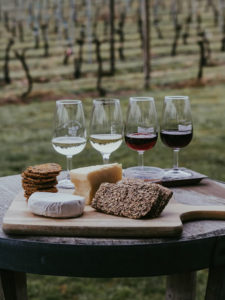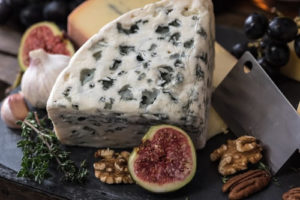Cheese and Wine Pairing Guide
 Where does the myth that cheese and wine are good companions come from? We suspect that the perfect partnerships that exist between, say, Roquefort and noble late harvest wines, or goat’s-milk cheese (Chevin) and Sauvignon Blanc, made us believe that all cheeses go well with most wines.They don’t. In fact cheese is one of the trickiest foods to match with wine.
Where does the myth that cheese and wine are good companions come from? We suspect that the perfect partnerships that exist between, say, Roquefort and noble late harvest wines, or goat’s-milk cheese (Chevin) and Sauvignon Blanc, made us believe that all cheeses go well with most wines.They don’t. In fact cheese is one of the trickiest foods to match with wine.
But why are we Surprised
But why are we surprised? Many cheeses have a strong taste and are pungently aromatic; they can have a high fat, salt or acid content, and some have a sticky texture that coats the tastebuds. All these challenging features spell ‘trouble’ when comes to paring cheese with wine. What makes matters worse is that cheeses differ from cheese-maker to cheese-maker. A lot also depends on whether they are ‘young’ or ‘old’, as many cheeses take on a different personality when matured; for example a young Gouda is poles apart in flavour, texture and aroma from a matured one. To crown it all the tried and tested principle of matching the weight of the food to the weight of the wine no longer applies when it comes to cheese; alas, the theory of pairing a ‘big’ cheese with a ‘big’ wine flops more often than it succeeds. Head for the hills if someone pours you a full-bodied, powerhouse Cabernet Sauvignon to drink with a wedge of Roquefort; to put it rather mildly, this is not a pleasant match. Contrary to popular belief, white wine performs best with cheese. And, generally speaking, it is the sweeter wines that make the best matches.
In Old World Countries
In old world countries, with their long history of winemaking and their culture of drinking wine with food, cheese and wine are looked upon as bedfellows. Italians or Spaniards wouldn’t dream of serving cheese without an accomapnying glass of wine, while the French have very interesting, sometimes very definite, ideas of which cheese match which wines. Of course these parings are mostly based on regional wines matching regional foods. However, many cheeses come from areas where no wine is made, and regional matches are not always the best ones.
Cheese and Wine Parties
In the 1970s, when cheese and wine parties were popular in South Africa (and other countries without a tradition of drinking wine with food), it was semi-sweet white wines (the order of the day at the time) that led us to believe that wine and cheese were natural partners. For most of us, this was our introduction to matching food and wine. Unsurprisingly, though, once sweet wines started to wane in popularity, the cheese and wine party started to die out. But South Africans still love a glass of wine with cheese, even if they are not natuiral ‘taste’ partners. And why not? The trick is knowing which wine to serve with which cheese. Reading the back labels on wine bottles is usually no help: the suggestion ‘serve with cheese’ leaves unanswered the crucial question of ‘which cheese?’
Key points to note when pairing cheese and wine
 Acidity cheese and wine both have acidity, when you serve a cheese with pronounced acidity, such as goat’s-mik cheese (Chevin), match it with a wine of equally firm acidity, such as a Sauvignon Blanc, Chenin Blanc or Sangiovese.
Acidity cheese and wine both have acidity, when you serve a cheese with pronounced acidity, such as goat’s-mik cheese (Chevin), match it with a wine of equally firm acidity, such as a Sauvignon Blanc, Chenin Blanc or Sangiovese.- Texture Consider the texture of the cheese and then match or contrast it to the wine. For instance, match a smooth, creamy textured cheese with a full-bodied, velvety Chardonnay, Semillon or Viognier. Or, for contrast, pair it with the exact opposite – a palate-cleansing, dry sparkling wine that will highlight the texture of the cheese..
- Protect the wine Whether you are choosing a wine to accompany the cheese, or selecting a cheese to serve with a favourite wine, the objective is the same: to let no harm come to the wine. A wine should taste just as good with the cheese as it does on its own When we talk about a succesful cheese and wine match, we are actually saying that the cheese did not subtract from our enjoyment of the wine. Cheese is the dominant taste element, so we seldom have to think about how a wine will affect the cheese.
- Tannin Because cheese objects to the tannins in red wine, wines with soft tannins are the most succesful matches. But don’t haul out your carefully matured vinous treasures, as they will be overwhelmed by the by the complex flavours of most cheeses.. Save your best wines for another day (or serve them earlier in the meal). If you want to serve cheese witha red wine that has strong tannins, opt for hard cow’s-milk cheeses, provided they are not too strong in flavour, too salty, or matured for months on end. Salt emphasises tannins and the wine will taste bitter.
- Blue cheese The veins of mould in blue cheese strip many dry white and red wines of their fruit. A sweet wine is almost always a better choice. The saltier and more pungent the cheese, the sweeter and richer the wne should be. Sparking wines stand up well to many blue cheeses, which seems quite surprising, until you remember the theory of matching acidity with acidity!
- Mild cheese There are some mild cheeses such as Emmenthal, Edam Caerphili or Jarisberg, which you may think should pose no threat to wine, that are quite pernickety and not at all easy to match
- Soft cheese Soft cheeses made in the style of a Camembert or Pont l’eveque are the trickiest to match, especially when they have matured. For the sake of the wine serve them before they become too runny and pungent.
- Sweet accompaniments A well-made cheese needs no accompaniment to enhance it. It is easy to understand, though, why we often serve cheese with green fig or watermelon preserve, dried or crystallized fruits, fresh grapes or sweet relishes. Salty food loves sweetness, which is why it is a good match with sweet wines. When cheese is served with sweet accompaniments, you need to match sweetness with sweetness, as the cheese is no longer the dominant factor in determining the wine choice. Consider serving a brilliant cheese without accompaniments, letting the cheese and wine speak for themselves.
- Bread and biscuits Mnay people prefer eating cheese, especially soft, creamy cheeses or a pungent blue, with biscuits or bread. Choose unsalted, unflavoured biscuits that will not interfere with the taste of the cheese or the wine. You can’t go wrong with a plain baguette or a non-sourdough loaf made simply of flour (brown or white), yeast, water and salt. Breads containing herbs, olives, sundried tomatoes, sugar, added fats and other embellishments are not good choices. There is one exception, though: walnut bread with Camembert, served with a glass of nutty Chardonnay.
- Temperature Cheese always tastes best with wine when the cheese is served at room temperature. When the cheese is too cold, its flavours are muted and cannot latch onto the flavours of the wine. A small wedge requires about an hour to reach reach room temperature after you have taken it out of the fridge; larger peices need more time.
- Cheese in cooking Pairing wine with cheese in cooked dishes is no problem at all. In fact cheese souffles are a very good way to show off your finest red and white wines.
extracted from “The Food & Wine Pairing Guide” by Katinka van Nieker, Brian Burke
